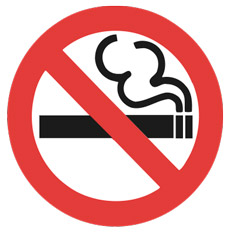An occupier in relation to an enclosed public place, means a person or business that has the management or control, or otherwise being in charge of that place. The occupier may be the owner, proprietor, manager or supervisor of an enclosed public place.
Display no smoking signs
Occupiers of liquor licensed premises (where alcohol may be sold without accompanying a meal) must display signs that comply with the requirements (outlined below) at all public entrances to an enclosed public place, in such numbers and positions so they are clearly visible to a person at the entrance to the place.
Enclosed public places that are subject to a restaurant liquor licence (where alcohol may only be sold when accompanying a meal) are not required to display signs, because smoking is not permitted anywhere on such premises

The signs must contain:
- the phrase no smoking or smoking prohibited in letters that are at least 20 mm in height
or
- the smoking prohibited symbol with a diameter of at least 70 mm
or
- other words or symbols that indicate clearly that smoking is prohibited.
Stickers that comply with the above requirements are free and can be ordered online via the Department of Health Online Publication Ordering System (external site).
See the different types of signage available – No Smoking Signage (PDF 1.23MB).
Preventing the spread of smoke from outside an enclosed public place
Smoking is not allowed within 5 metres of a public entrance to an enclosed public place and within 10 metres of air conditioning intakes.
The No Smoking outside enclosed public places guide (PDF 1.25MB) demonstrates the current legislation requirements.
If an enclosed public place is not provided with adequate ventilation in accordance with the requirements of the Building Code of Australia 2006 (the BCA), occupiers must take reasonable steps to ensure that smoke from a tobacco product does not enter the enclosed public place.
Reasonable steps may include but are not limited to the following:
- Close doors or windows.
- Designating outdoor smoking areas away from entrances and openings to an enclosed public place
- Restrict smoking around air intakes for ventilation equipment
- Anything else which may assist in preventing the spread of smoke into an enclosed public place.
Educating employees
Occupiers of enclosed public places are strongly encouraged to ensure all employees are aware of the law and their obligations under the legislation.